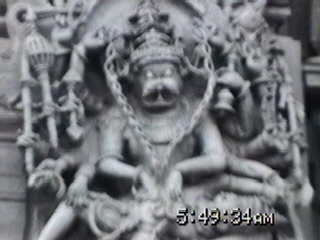The hill temple of Simhachalam can be seen as one approaches Vishakapatnam from Vizianagaram by train. Simhachalam - the hill of the lion is located at a distance of 18 km from Vishakapatnam. The hill temple is accessed via a motorable road, up the hill. This temple combines the Orissan and Chalukyan features of temple construction, and it attracts scores of pilgrims from both Andhra Pradesh and Orissa.
The presiding deity here is Varaha Lakshminarasimha, combining the iconographic features of Varaha and Narasimha. The image resembles a Shivalingam covered with sandal paste. It is only once a year, during the Chandana Visarjana that the sandal paste is removed, and the image is seen by pilgrims.
Legend has it that the Ugra form of Narasimha as he killed the demon Hiranyakashipu was so fierce that the image is kept covered by sandal paste throughout the year.
Temple History: Kulottunga Chola I of Tamilnadu, made endowments to this temple, as evidenced from inscriptions dating back to the year 1087. The Vengi Chalukyas of Andhra Pradesh renovated the original shrine in the 11th century. Much of the structure as it stands to day is the result of renovation by Narasimha I, of the Eastern Ganga dynasty, in the second quarter of the 13th century CE. Krishna Deva Raya, the Vijayanagar monarch visited this temple in the year 1516, as seen from inscriptions here. There are as many as 525 inscriptions in this temple.
Noteworthy features of the temple: This temple boasts of a beautiful stone chariot drawn by horses. The Kalyana Mandapa within the temple has 16 pillars with bas reliefs depicting the incarnations of Vishnu. Narasimha, the man lion incarnation of Vishnu is seen in several depictions throughout the temple.
The artwork here has elements of similarity with that of Konark. Elephants, flowers and plants are portrayed in plenty. The outer walls of the sanctum depict images of a royal personality (said to be King Narasimha) in various postures.
Narasimha Avataara - The Man-Lion Incarnation of Vishnu
This legend narrates the story of Narasimha - the man lion incarnation of Vishnu where he demonstrated his omnipresence and destroyed the demon Hiranyakashipu.

Hiranyakashipu the demon king, was blessed with immense powers by virtue of his penance to Bhrama. Endowed with a boon that neither man, nor beast nor weapon could kill him; nor would he die indoors or outdoors, he assumed total invincibility and conquered the earth and the nether worlds. Intoxicated by his victory, he declared himself as the lord of the universe, and directed his subjects to worship none other than himself.
The only one of his subjects to defy his orders was his own son Prahlada, a staunch devotee of Vishnu. Hiranyakashipu tried several means to convince his son, and then to kill him indirectly, and none worked. Finally he challenged him to show him Narayana, whom he worshipped so fervently. Prahlada insisted that Vishnu was omnipresent and that there was no need to show him. An enraged Hiranyakashipu broke open a pillar in front of him, to disprove his son's assertion, and out of this pillar sprang out Narasimha, the man-lion form of Vishnu, who killed him on his doorstep, placing him on his lap.
Narasimha is hailed as one of the 10 avataras of Vishnu. The Nava Narasimha shrine at Ahobilam in Andhra Pradesh, enshrines nine forms of Narasimha. Other major temples enshrining Narasimha include Tiruvaali near Chidambaram, Tiruvelukkai in Kanchipuram, Tiruneermalai near Chennai, and Sholingur near Chennai all in Tamilnadu. The hill temple of Simhachalam near Vishakapatnam also enshrines Narasimha.


No comments:
Post a Comment